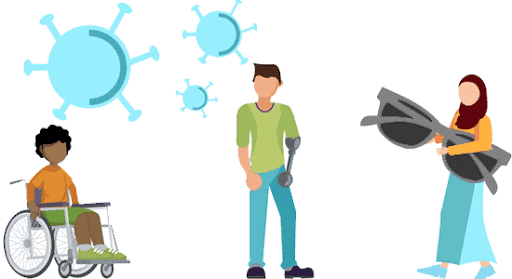
Abled does not mean enabled. Disabled does not mean less abled.
Khang Kijarro Nguyen
Disability, whenever we hear this term, the very primary notion which comes in our mind is the image of a person who cannot talk or walk properly or somewhere incapable to do certain tasks. So now, what is Disability? It is a condition that makes it difficult for a person to do a task or activity normally and affects how they interact with the world. Disability is a condition that may be cognitive, developmental, mental, physical, sensory or a combination of various factors. Whilst, the Convention on the Rights of Persons with Disabilities does not provide a definition of disability, it instead provides a broad description intended to be widely inclusive.
The CRPD establishes in its Article 1 that persons with disabilities include those who have long-term physical, mental, intellectual or sensory impairments which in interaction with various barriers may hinder their full and effective participation in society on an equal basis with others. This description of disability shifts the focus towards the social and environmental barriers that hinder an individual’s participation in society rather than on the individual’s impairments.
The term “disability” has different meanings in different groups. In medicine, for instance, it is looked upon as something that needs to be fixed. Whereas, others view it as a sort of restriction imposed upon by an ableist society, which perceives the so-called disabled persons to be inferior to them.
Different perspectives bring different concepts to the table. Every human deserves a life of dignity and rights, but people with disabilities receive a lot of discrimination and social stigma further deteriorating their chances of leading a normal human life with others every day. They are denied their rights to be included in the general school system, to be employed, to live independently in the community, to vote, to participate in sports and cultural activities, to enjoy social security, to access justice. Hence, there is an urgent need to study the various laws and rights related to people with special abilities, to help reduce the gap between the abled and disabled. In this article, we will discuss the different human rights of differently-abled people both in the national and international context.

The main purpose of human rights for differently-abled persons is to secure equal opportunities and equal rights for people with disabilities. The specific goals and demands of these rights are access and security in transportation, architecture, and the physical environment; equal opportunities in independent living, employment, education and housing; and freedom from abuse, neglect, and violation of patient’s rights.
The International Framework
The declaration of the Rights of Disabled persons was made on 9th December 1975 by the General Assembly of the United Nations and was the 3447th resolution made by the assembly. Under this, the disabled person can enjoy all the rights without any discrimination. The right to live a human life with dignity and freedom irrespective of the seriousness of their disability or handicap. Differently-abled people have the same civil and political rights as other humans. The measures curated for disabled people are such that they become self-reliant, as per their capabilities.
They also have a right to engage in social and economic activities, including the right to retain employment and engage in other productive and remunerative activities; the right to join trade unions, etc. Disabled people have the right to live life with the same level of freedom and expression as other members of the society and have a right to be protected against degradation, exploitation and discriminatory practices of any sort.
The Provisions of this declaration defines a “disabled person” as anyone who cannot ensure the requirements of a normal human or social life, due to some physical or mental deficiency and the disabled person shall not be discriminated on grounds of – religion, race, caste, sex, colour, place of birth, language, or any political or other opinions. Following, we come to the Convention on the Rights of Persons with Disabilities, adopted on 13th December 2006 at UN Headquarters, New York.
The convention elaborated on its earlier promises to change people’s view against the differently-abled from mere “objects of charity” to self-reliant individuals with the same fundamental rights as others, tightly integrated into mainstream society. Increasing the participation of the disabled community, both in the developed and developing countries, in political, social and economic discourse. The Convention’s main motive revolved around categories of rights that apply to people with disabilities and identification of areas where certain modifications have to be made, to effectively help the disabled realize their rights, and if in some cases there have been violations, to efficiently reinforce their rights.
Disability is natural. We must stop believing that disabilities keep a person from doing something. Because that’s not true . . . having a disability doesn’t stop me from doing anything.
Benjamin Snow
Rights of Disabled Persons in India
Article 14 talks about Right to equality, further article 15 talks about a more specific dimension of the principle of equality, relating to discrimination by the state on grounds of – religion, race, caste, sex, or place of birth. Thus, Article 15 protects the citizens from discriminatory activities of the state. Article 15(2) reads, “No citizen shall, on grounds only of religion, race, caste, sex, place of birth or any of them, be subject to any disability, liability, restriction or condition with regard to (a) access to shops, public restaurants, hotels and places of public entertainment; or (b) the use of wells, tanks, bathing ghats, roads and places of public resort maintained wholly or partly out of State funds or dedicated to the use of the general public.”
Persons with Disabilities Act, 1995 came into force on 7th of February 1996, which was a significant step to ensure equal opportunity and treatment for people with disabilities to join the nation-building movement. The Act provides for both the promotional and preventive restoration aspects such as education, employment, vocational training, research, reservation, manpower development and unemployment allowances. According to this Act, under Section 2(I), “disability” includes blindness, low vision, leprosy-cured, hearing impairment, locomotor disability, mental retardation and mental illness.
In National Federation of Blind v. UPSC, the Supreme Court directed UPSC to allow blind people to appear for the examinations. In order to avail certain benefits and concessions a disabled person must possess a disability certificate, the state medical board under the state government can issue a disability certificate to anyone with over 40% of disability. People over 18 years of age, with over 80% of disability and living below the poverty line are also entitled to the disability pension under the Indira Gandhi National Disability pension scheme. Various NGOs in India are dedicated to this and help people get their disability pension.

Conclusion
Persons with disabilities are among the most ignored sections of our society. This is due to the sheer indifference of society which subjects such people to discrimination and antipathy. Governments must make a commitment to community living in order to ensure the right of persons with disabilities to living in the community. No society is worth living in if it does not consider people who suffer through physical or mental impairment. Disability is a sad reality, which not only affects the natural way of living but also injects despair and hopelessness.
If we wish to create a world where everyone is treated with respect and dignity, we must give back these people their due share, and work towards an inclusive society where everyone feels integrated and productive. Ensuring that people with disabilities do not feel invisible and side-lined is the collective responsibility of our society. There must be a drastic change from charity oriented, medical-based approaches to one based on human rights.
The severity of one’s disability does not determine their level of potential. The greatest barriers that persons with disabilities must overcome are not steps or curbs, it’s expectations.
Karen Clay, Professor of Economics and Public Policy